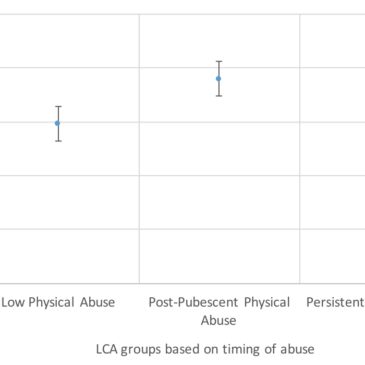Child abuse is an ongoing public health problem and can have serious consequences for kids as they emerge into adulthood. For example, childhood physical abuse can impact later drinking behavior and increase risk for alcohol abuse. This week, as part of our Special Series on Addiction and Domestic Violence, The DRAM reviews a study that examines whether specific patterns of childhood physical abuse lead to more risk for future adult drinking problems.
What is the research question?
Does the timing of physical abuse play a role in alcohol use during young adulthood?
What did the researchers do?
Researchers recruited participants by posting print and online advertisements within a single metropolitan area. The advertisements asked for young adults between the ages 18-25. Participants were initially screened and excluded if they were not within the age range or had poor health. A total of 300 participants completed a variety of questionnaires that asked about the occurrence of childhood trauma/abuse, personal and peer alcohol use, and psychological distress.
What did they find?
Researchers used a latent class analysis to group their sample into three classes: 60.2% of participants experienced no or low physical abuse , 14.5% of participants experienced physical abuse after reaching puberty, and 25.3% of participants experienced physical abuse throughout childhood. They found those who experienced physical abuse after puberty drank as frequently as those who were physically abused persistently, and both groups drank more frequently than those who had experienced low physical abuse (see Figure).

Figure. Estimated mean drinking frequency in the 3 participant groups. Figure recreated from Shin, S., Chung, Y., Rosenberg, R., 2016. Click image to enlarge.
Why do these findings matter?
These results show that being physically abused in adolescence seems to have as serious an impact as persistent abuse. This suggests that there could be specific periods in a child’s life that are more sensitively influenced by physical abuse; therefore, depending on the timing and duration of the abuse, children may be put at increased risk for alcohol problems. This information can be used to educate, intervene, and hopefully prevent excessive alcohol use or other risky behavior later in life.
Every study has limitations. What about this one?
Limitations can found in the lack of information collected on drinking behavior. Researchers only asked participants about their drinking habits in the past 12 months. A broader look at their lifetime drinking habits and the age they started drinking is valuable information that could have been used to establish a timeline that examined physical abuse and drinking behavior more thoroughly.
For more information:
To learn more about child abuse and access the national child abuse hotline please click here.
If you or a loved one has a problem with alcohol, please visit our first steps to change here.
— Alec Conte
What do you think? Please use the comment link below to provide feedback on this article.




